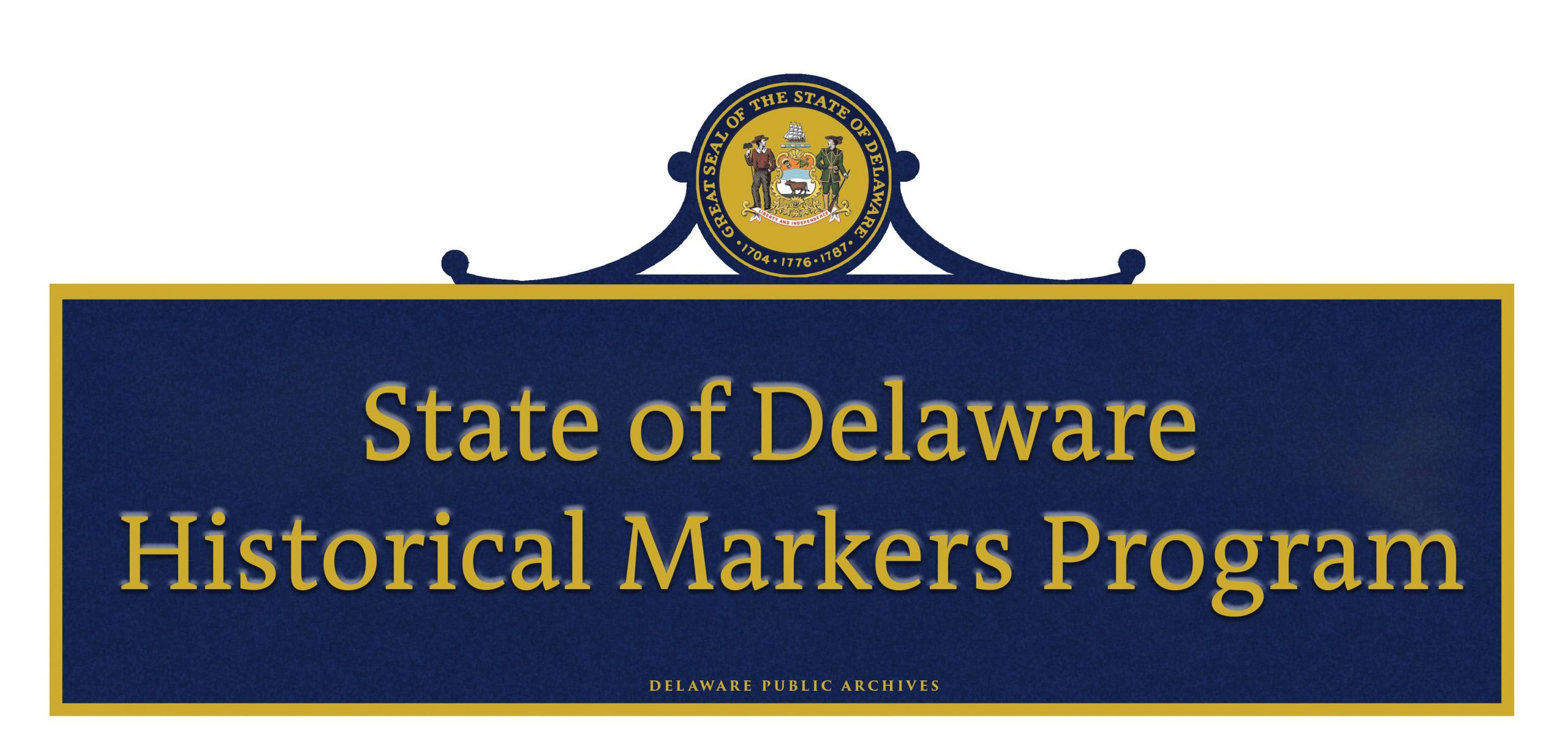The Archives will be closed on Thursday, January 1st, in observance of New Year's Day. More Info


The State of Delaware Historical Markers Program traces its origins to 1929, when Governor C. Douglass Buck appointed a committee to review Delaware’s notable historic sites and develop a way to identify them. In 1931, the General Assembly of Delaware passed an act establishing a commission to erect historical markers throughout the state. The markers in each county were numbered sequentially as they were proposed, preceded by NC (New Castle), K (Kent), and S (Sussex) to note the county in which they were located. Since the 1930s, the State of Delaware has erected over 700 markers. The Delaware Public Archives has administered the Historical Markers Program since 1990.
Community members and the state legislature have always played active roles in the Historical Markers Program. Today, every new state historical marker is the result of partnerships between the Delaware Public Archives, state legislators, and local community members. Funding for each marker is obtained through direct requests to members of the General Assembly from the Delaware Public Archives on behalf of interested individuals and organizations. As a result, the markers represent Delawareans’ shared history and become a source of pride for local communities.
As of January 1, 2025, the total cost of a new historical marker is $3,310. The cost includes the marker fabrication, shipping, and installation. Historical markers are funded by state legislators using public money from the state Community Transportation Fund. After the application is approved, the Delaware Public Archives will work to secure financial support for the marker, which must be obtained from the legislators representing the district where the marker will be placed.
The Historical Markers Program has been in existence since 1931, and the style of historical markers has changed over time. The Delaware Public Archives continues to maintain the older styles of historical markers, but only produces new powder-coated, cast-aluminum markers. The current markers are high-quality, durable roadside signs that highlight the concise histories of significant sites. The narrative section of the current style of markers has a limit of 650 characters, including letters, spaces, and punctuation.
Please contact the Delaware Public Archives to learn more about any historical marker subject.
The Delaware Public Archives is actively adding markers to the website on a weekly basis to have all markers administered through the State of Delaware Historical Markers Program available online.
This website only lists markers that were installed as part of the Delaware Public Archives’ Historical Markers Program. It does not include markers and plaques placed by communities or private entities. If you find an error on the online inventory and/or if you believe a marker has been left off the website, please contact the Historical Markers Program Coordinator.
Use the Report a Missing or Damaged Marker form on the website to report a missing or damaged historical marker or contact the Historical Markers Program Coordinator at historicalmarkers@delaware.gov or 302-744-5000.
Once the Delaware Public Archives is notified about a damaged marker, the damage will be assessed, and the next steps will be determined.
Historical markers are the property of the State of Delaware. Please do not attempt to relocate, repaint, or repair markers on your own. The manufacturer must make most repairs of the marker. Relocations must be completed by authorized vendors. Attempting to relocate or repair the marker on your own will damage the marker, possibly irreparably.
Only the Delaware Public Archives is authorized to install historical markers. We work with a local company to professionally install all markers, which ensures that markers are installed consistently and in accordance with the manufacturer’s specifications and the Delaware Department of Transportation’s guidelines.
Historical markers are the property of the State of Delaware. Once installed, markers cannot be repaired, refurbished, or relocated without permission from the Delaware Public Archives. If you recognize that a historical marker needs attention, please submit a Missing or Damaged Marker Form and/or contact the Historical Markers Program Coordinator.
Markers are the property of the State of Delaware. All damaged markers must be returned to the Delaware Public Archives.
The Delaware Public Archives accepts and reviews applications for new historical markers on a rolling basis throughout the year.
Please see the information on Historical Marker Criteria and Eligibility. A few things to note about new historical marker topics:
Listing on the National Register of Historic Places is an honor, but it does not automatically qualify a site or structure for a State of Delaware Historical Marker. A new marker application is still required for these topics and locations.
If you are looking to obtain a National Register Marker for your site or structure, please note that these are not provided by the Delaware Public Archives. However, you may visit The National Park Service: National Register of Historic Places for more information.
The Delaware Public Archives expects that research on the marker subject has been completed prior to submitting a new marker application. Copies of this research, including citations, must be submitted with the marker application. Failing to do so will considerably delay the application review process. The Historical Markers Program Coordinator will conduct additional research into the subject using the Archives’ resources to fact-check and clarify details.
The Historical Markers Program could not be successful without the support of state legislators. However, the program is an outreach of the Delaware Public Archives, which maintains oversight of the markers throughout the state. The Archives utilizes established criteria and an application process to ensure that historical markers accurately represent state and local history. Once a historical marker application is reviewed and approved, the Historical Markers Program Coordinator works with state legislators to confirm and secure funding for the new markers.
Each historical marker project is unique and involves a variety of considerations. From research and writing to site selection and scheduling, any stage of the process can affect the overall timeline.
On average, a new marker process typically takes between 18 and 24 months from application approval to marker dedication. Marker fabrication itself can take 4 to 6 months or more. If you hope to dedicate a new historical marker for a particular event or anniversary, please initiate the process early.
Yes. The Delaware Public Archives (DPA) will lead the coordination of the main unveiling event in partnership with the original applicant. The Historical Markers Program Coordinator and applicant will work together to determine a suitable date and finalize details.
Please note: An unveiling date will not be confirmed until the shipping date for the marker has been provided by the manufacturer.
DPA will:
Applicants are welcome to organize additional activities beyond the main unveiling (e.g., receptions, tours), but should coordinate with the Historical Markers Program Coordinator to avoid conflicts.
DPA handles:
The Applicant and interested community members are responsible for:
Please confirm the availability of key guests before publicizing the event.
While each ceremony is tailored to the subject and community, most programs include:
Unveiling events generally run 20 to 30 minutes and are held outdoors. Please keep in mind:
These are standing events; DPA does not provide tents or chairs, but applicants are welcome to arrange for them if desired.
DPA will provide a simple printed program that includes:
Sample programs from past unveilings are available upon request. If you’d like to include logos, sponsors, or additional elements, you may create a separate handout or collaborate with the Program Coordinator.
Yes—but to keep the event concise, we recommend limiting the number of speakers. If other individuals (e.g., historians, educators, community leaders) played a key role and should be recognized or invited to speak, please notify the Historical Markers Program Coordinator early in the planning process.
DPA will bring:
DPA does not provide:
If your organization or municipality would like to provide additional equipment or services, you are encouraged to do so.
Applicants are welcome to pursue transportation options (such as arranging a bus for attendees), but these should be coordinated independently. DPA is happy to assist with planning guidance, but cannot guarantee logistical support beyond the core ceremony.
For example, for a former unveiling, a school district was contacted to explore the possibility of providing a bus for guests to the marker site from the parking location. While not necessary, such efforts are appreciated and can improve accessibility.
The Delaware Public Archives will post an advisory on news.delaware.gov for every historical marker unveiling to notify the public and media of the event details.
In some cases, the Archives may also issue a formal press release in addition to the advisory. The decision to release a press statement is made at the discretion of the Archives and will depend on factors such as the subject matter, public interest, and timing.
Please reach out to the Historical Markers Program Coordinator at the Delaware Public Archives for help with:
We look forward to working with you to celebrate and share Delaware’s rich history!
Last revised: August 19, 2025.